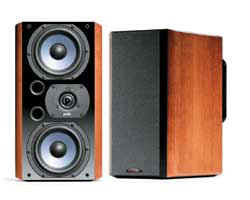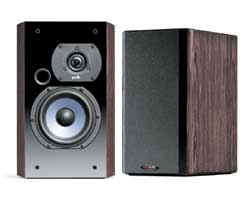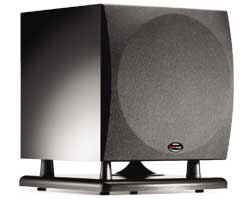You are reading the older HTML site
Positive Feedback ISSUE
4polk audio
My Polk SACD Surround Rig
by Max Dudious
Yo Dudes! And Yo Dudeens! It’s good to be back. Before I get going, on the suggestion of a fan I visited www.ucomics.com/tedrall and was greatly amused by a comic strip dated 11/07/02 that began, "John Ashcroft has announced the arrest of some dude who was clearly up to no good." Though I’m no doubt the East Coast Distributor of Dudeliness, I don’t think this comic strip has anything to do with me. I am not just "some dude." But we may have to mount a "Free Some Dude" campaign. I’ll keep an eye on this one as it develops.
This time around I’ll be one of the dudes reporting on the multi-channel
stuff going on, developments in the technology of recording technique, the latest
software, and in the production of quality hardware through which to listen. Believe me,
this is no small task because hellzapoppin’ out there in multi-channel. With
colleagues like recording engineer dude Steve Hoffman, and hardware designer dude Ed
Meitner to fall back on, how can I miss? You might think of me as "Multi-Channel
Max," and I’ll do some reconnoitering of the field for the PosFeed
community, to share with you who have neither the time nor inclination to reconnoiter.
I’ll start in with the description of my multi-channel speaker system.

Polk LSi9
After much uffish thought I decided to go with the Polk system based as it is on their aerated polypropylene 5.25" mid/woof and the much celebrated Vifa XT25 ring-radiator, or tweeter. This combination is in all the speakers in this rig to ensure similar timbre: Polk’s LSi9 (their quasi D’Appolito design), their LSi7 (a two way), and their LSiC or center channel (a horizontally configured LSi9). The 9’s are in the front, the 7s in the rear, and the center channel is where it should be. There is also a powered 8" long-throw sub-woofer, the PSW-550, and it knows its place. I was impressed with this line of speakers when I first heard them about a year ago at the ‘01 High End show in N.Y. They sort of floored me, actually. Power, delicacy, great spatial presentation, and nearly as good as I’ve heard from top to bottom. Great value for money. Great reproduction of all sorts of music. A truly good speaker. Is that merely my opinion? No. The same Vifa tweeter is used in Krell’s $10,000 LAT-2, and a few other loudspeakers in the way high end.

Polk LSi7
One well-respected reviewer, Anthony Cordesman, had a pair of Polk’s model LSi-15’s, (the LSi9 on top, with an 8" unpowered woofer at $1740/pr MSRP), at his house at the same time as the Dynaudio Evidence Temptations (at $35K/pr MSRP), and I guess the temptation for evidence, to compare them A/B, was too great for the dude. His report in The Absolute Sound (April-May, 2002) on the LSi-15’s claimed the midrange and treble outperform many speakers at twice their price, or more. According to Cordesman, "No, it is not up to the upper-octave performance of a pair of $35,000 Dynaudio Evidence Temptations, but it also is not embarrassed by a direct comparison." If he had a bone to pick with the Polk LSi-15’s, it was; "As might be expected, the bass is not quite as good." Well, sure. What do you expect from the Polks that cost about 5% of the Dynaudios?
Maybe Tony was "some dude".
I’ve heard the Dynaudios fill a 40’ x 40’ hotel demonstration room with ease. Most of us don’t have dedicated listening rooms that large. In fact, most of us live in the real world where our listening rooms serve double duty as dens, or home offices, or even living rooms. And we know how rooms less than 32’ long may affect bass reproduction adversely. So, I figured, my little office (14.5’ x 15.5’ with three doors, two windows, and a staircase going up and down) might not be so atypical. I thought I’d design a multi-channel system for my office that could serve as a model for others who (like me) have to make do in more cramped quarters than Dynaudio of North America. I also have a theory�yeah, another of my half-baked theories�that if I can control the direct sound of my multi-channel system, I won’t have to worry so much about room reflections as I do with my big stereo rig downstairs. (I invite all of you out there to tell me what you can about your multi-channel room problems and solutions you’ve been able to improvise.) I expect I’ll be working toward optimizing my multi-channel office for the foreseeable future. And of course I’ll share what I can with you.
I’ve listened seriously to some half-dozen multi-channel systems, and the most unbelievable one was David Chesky’s mastering studio. His loudspeakers at the time were the supersmooth Parsifals by Verity, and I say that because he often changed speakers the grail quest for perfect sound. Most speakers have some coloration or another, ranging from "forgiving and musical" on one end of the spectrum, to "unforgiving and analytical" on the other. By "forgiving and musical" I mean the speakers are set up so the hand of the recording engineer is not apparent. Often the engineer’s thumbprint manifests itself in audible reverb and decay, which can be added or subtracted according to the judgment of the engineer, and is immediately noticeable. Some listeners feel this is a distraction and would rather not hear it, while others feel everything on the recording should be evident. Speaker reviewers seem to feel that sometimes the limited range of detail revealed goes beyond "forgiving and musical," to "indistinct," to "irritatingly syrupy." On the other end, speakers that seem to appeal to the sharp-eared sometimes go beyond "unforgiving and analytical," and are reviewed as "etched," or "irritatingly harsh." Chesky’s speakers in his room sounded a tad "forgiving and musical." Of course three pair of Parsifals had the tonal balance, the dynamics and power, the dispersion and imaging, we’ve come to expect from truly great speakers in a big room.
I’d say the Polk are a tad on the "forgiving and musical" side. Listening to them on some older recordings, when the engineers were not as subtle as the best of them are today, I was able to hear the engineer’s hand on the controls, but I had to know it was there, and I had to crank the volume to confirm it. On my remastered CD of Louis Armstrong and Duke Ellington (1961), The Great Summit/The Master Takes, (Roulette Jazz 7243 5 24547 2 3) there was a noticeable amount of reverb on Satch’s solo singing. My big stereo rig caught that immediately. It wasn’t offensive, but it was noticeably there. Through my Polk rig (in stereo with sub) the reverb seemed farther back down into the mix. I’d say my big rig is less forgiving and more analytical; and, the corollary, the Polk rig is more forgiving and musical. Neither is offensively overmuch in their "personality." This is inherent in the speakers, I thought, not the electronics nor cabling. To confirm this impression, I took the relatively small LSi9’s downstairs and listened to them in my big rig. My judgment was confirmed. All this to make sure that my impressions were accurate, and to justify your trust in me as advance scout of multi-channel. The Polks are on the sweet rather than brash side of the continuum.

The Polk 8" long-throw SW550 sub-woofer is above average for a powered sub, and one step down from Polk’s best dual 10" sub, which I think was designed for larger rooms. It gets down to its deepest register very well, being quick and lithe, able to impress with the thunder of organ pedal tones, yet delivering equally well the speed and pitch, attack and decay, required to reproduce a plucked bass viol with accuracy. Going up and down the scales on a typical bass solo, the SW550 (in my room, with my electronics) sounds neither too chesty nor nasal, and the crossover point to the LSi9s is indistinguishably seamless. I think this driver was designed with the Polk LSi9’s in mind, and maybe more importantly, for rooms about the size of my office. With all the doors to my office open, the bathroom, bedroom, and TV room are all filled with bass. When I close the doors to contain the bass, the whole room gets down and boogies with Junior Wells’s bassist, Bob Sunda. I’d say there is adequate bass for just about every style of music. Of course the knee of the roll-off is adjustable, as is the level, on the back panel of the sub, so "bass-management" is designed for tweaking to taste.
Both Tony Cordesman (in TAS), and Doug Schneider (in his April 2002 review in Home Audio Equipment Review) have commented on how well the LSi9’s work as stereo pairs. They could be the basis for a home theater system that would be called on to serve double duty as a dual-function system. Now we, at PosFeed, know that many of you deep-pocketed readers are not so snobby as to reject that idea out of hand. Sure, a multi-purpose system that offers high-class audio and uses that audio as accompanist for video reproduction would be nice. Our marketing satellite observations of you sitting there in your executive desk chair, from which our computers have estimated your annual disposable income, have corroborated that you wouldn’t turn your nose up at such an idea. Sometimes a little dudeliness profiling can be a good thing. Hey, watch it. This Dude might be up to some good.
This is not a review of the Polk speakers. It is a justification of why I chose them, when I might have begged any of the numerous loudspeaker manufacturers into participating in this project. For the moment, Polk loudspeakers are included in my reference surround system, through which I’ll be reviewing multi-channel electronics and CDs. They were favorably reviewed in the journals, and they live up to my standard of "Champagne taste on a Chardonnay budget." I’m also using the Marantz 8260 SACD multi-channel CD player, the Marantz 9200 (THX Ultra II) receiver, and Monster Cable interconnects and speaker cables. This represents audio quality high enough for audiophiles to appreciate and, while not the least expensive, it is a far cry from the prices usually associated with High-End systems.
The system delivers High-End sound on a modest budget. There are guys who spend double what this whole system costs on room treatment, or cabling. Anyone can solve an audio problem by throwing money at it. I’m going to try to keep things reasonable, with domestic tranquility in mind. You’ll have to check out my choices for yourself, if you have the time and inclination.
Polk Audio
web address: www.polkaudio.com
